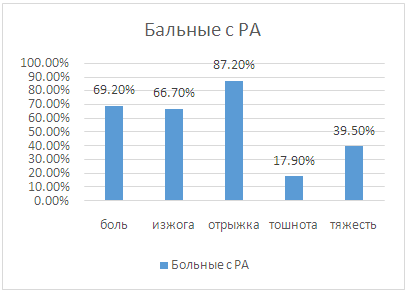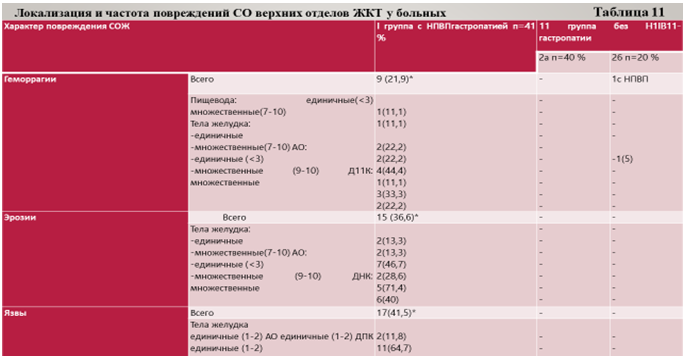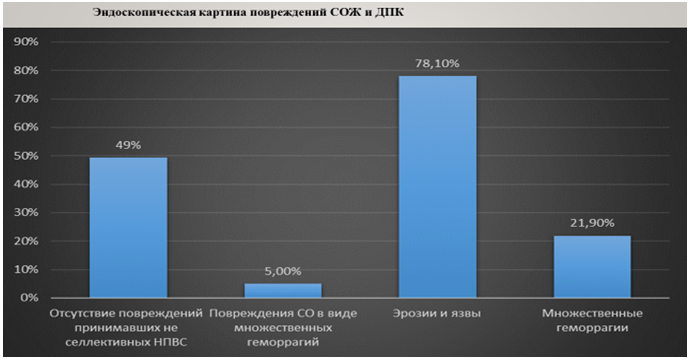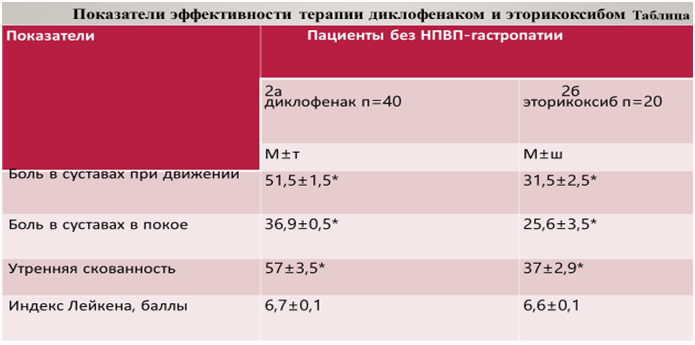-
Paper Information
- Next Paper
- Previous Paper
- Paper Submission
-
Journal Information
- About This Journal
- Editorial Board
- Current Issue
- Archive
- Author Guidelines
- Contact Us
American Journal of Medicine and Medical Sciences
p-ISSN: 2165-901X e-ISSN: 2165-9036
2023; 13(2): 103-106
doi:10.5923/j.ajmms.20231302.16
Received: Jan. 7, 2023; Accepted: Feb. 1, 2023; Published: Feb. 15, 2023

Clinical and Laboratory Examinations of Nsaids -Gastropathy in Patients with Rheumatoid Arthritis
G. C. Khamidova1, G. Z. Shodikulova2
1Urgench Branch of the Tashkent Medical Academy, Republic of Uzbekistan
2Samarkand State Medical Institute, Republic of Uzbekistan
Correspondence to: G. Z. Shodikulova, Samarkand State Medical Institute, Republic of Uzbekistan.
| Email: |  |
Copyright © 2023 The Author(s). Published by Scientific & Academic Publishing.
This work is licensed under the Creative Commons Attribution International License (CC BY).
http://creativecommons.org/licenses/by/4.0/

This article records clinical and laboratory data in patients with gastropathy rheumatoid arthritis caused by nonsteroidal anti-inflammatory drugs. In addition to the above, the use of nonsteroidal anti-inflammatory drugs leads to serious gastrointestinal ailments. The clinical picture of EGDS is erosive and ulcerative wounds in the gastroduodenal zone. It is possible to reduce the frequency of the above complications by prescribing safer selective NSAIDs and gastroprotectors.
Keywords: Pain syndrome, Gastroprotectors, Gastrointestinal tract, Ulcerative lesions of the gastric mucosa, Study of biopsy specimens of the gastric mucosa
Cite this paper: G. C. Khamidova, G. Z. Shodikulova, Clinical and Laboratory Examinations of Nsaids -Gastropathy in Patients with Rheumatoid Arthritis, American Journal of Medicine and Medical Sciences, Vol. 13 No. 2, 2023, pp. 103-106. doi: 10.5923/j.ajmms.20231302.16.
Article Outline
1. Relevance
- NSAID belongs to the class of medicines that have a wide range of use in clinical practice. [6]. The field of application includes various pathological conditions accompanied by fever. [2]. Long-term use of NSAID at high doses is often found in rheumatology practice. This pathology is especially common in elderly ulcerative patients. [5]. The pathology is often the cause of death of patients with rheumatoid arthritis [3]. Early diagnosis, treatment and prevention of gastropathy induced by nonsteroidal anti-inflammatory drugs (NSAIDs) is one of the urgent problems, the importance of which is determined by the frequent development of this pathology that occurs with this complication, primarily gastric bleeding, in some cases with a fatal outcome [1,4]. In this regard, NSAID-induced gastropathy is often the main reason for discontinuation of therapy and prescribing medications aimed at treating gastropathy [6]. The purpose of our study was to evaluate the efficacy, tolerability and safety of the use of the Etoricoxib at a dosage of 90 mg once a day after meals for 4 weeks for the treatment of rheumatoid arthritis in patients with concomitant erosive and ulcerative lesions of the upper gastrointestinal tract in remission/moderate exacerbation against the background of prophylactic therapy with the pantap (pantaprazole) at a dosage of 20 mg 2 times a day with a comparison with the drug diclofenac.
2. Materials and Methods
- 101 patients were examined, who had a reliable diagnosis of RA, of an average degree of activity. The patients were of middle age (41+15, 8 years). Pathology of the gastrointestinal tract was detected by a thorough clinical examination. Of the 101 patients who were under observation, 76 women and 25 men with RA were treated, of which 41 (23.6%) with EFGDS at the first stage of the study, NSAID-gastropathy was detected. The comparison group consisted of 40 patients taking non-selective NSAIDs (diclofenac 150 mg/day) and 20 patients taking selective NSAIDs (etoricoxib -90 mg/day) without the development of gastropathy. The control group consisted of 15 practically healthy individuals. All patients underwent endoscopic examination.
3. Own Clinical Research
|
|
|
|
4. Conclusions
- The results show that etoricoxib has approximately equal efficacy and even has superiority in terms of safety. When using etoricoxib in patients with RA, dyspeptic syndrome develops in 5% of patients, gastropathy in 5%, characterized by multiple hemorrhages of the gastric mucosa, erosive and ulcerative lesions of the gastric mucosa are absent, optimal indicators of all parts of the hemostasis system and blood rheology are recorded. The efficacy of NSAID-gastropathy therapy with proton pump inhibitors determined with an assessment according to EFGDS data. Endoscopic observation of the dynamics of epitelization of erosive and ulcerative lesions of the gastric mucosa revealed significantly faster healing in the group of patients who received colloidal bismuth subcitrate as part of complex teraphy.
5. Discussion
- Thus, the clinical and endoscopic data revealed by us in RA patients taking NSAIDs may play a significant role in the development of clinical manifestations of NSAID-gastropathy and, possibly, a certain group of patients needs to undergo drug correction of symptoms associated with impaired motor skills.
 Abstract
Abstract Reference
Reference Full-Text PDF
Full-Text PDF Full-text HTML
Full-text HTML


